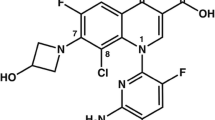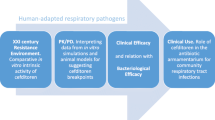Summary
Local antimicrobial therapy often has a beneficial effect in both acute and chronic infections of the respiratory tract. Indeed, contrary to systemic antimicrobial administration, inhalation or aerosolisation delivers the drug directly to the site of infection. Even at low dosages, this results in local effective drug concentrations, without adverse reactions.
The spectrum of antimicrobial activity of fusafungine, a cyclohexa-depsipeptidic antimicrobial of fungal origin for local use, has been defined by determination of the minimum concentration of the drug that inhibits the growth of 90% of the strains belonging to a species. The breakpoint concentration of fusafungine for clinical outcome is 40 mg/L. Fusafungine displays bacteriostatic activity on the Gram-positive cocci responsible for infections of the respiratory tract: Streptococcus (including S. pneumoniae) and Staphylococcus, including the methicillin-resistant (Methi-R) strains, which represent more than 30% of the strains isolated in hospitalised patients. Indeed, 60% of the 190 studied strains were Methi-R with the KTG-MLS phenotype and therefore resistant to all the antibacterials commonly used in infections of the respiratory tract, while only 7% of the strains were resistant to fusafungine. Moreover, in vitro, fusafungine did not induce either direct bacterial resistance or cross-resistance with systemic antibacterials. This suggests that there is no risk of selection of multiresistant microorganisms with repeated fusafungine treatments and that fusafungine does not interfere with the efficacy of concomitant systemic antimicrobial therapy.
Fusafungine also has antibacterial activity against Mycoplasma pneumoniae and Legionella pneumophila and antifungal activity against Candida albicans, 3 pathogens that are responsible for infections of the lower respiratory tract.
Subminimal inhibitory concentrations of fusafungine inhibit the adherence of Haemophilus influenzae to epithelial cells in culture, suggesting that this anti-adherence effect is involved in the therapeutic efficacy reported for the drug in Haemophilus infections of the respiratory tract, despite the high minimum inhibitory concentrations against this pathogen. Thus, fusafungine should prevent the colonisation of the nasopharyngeal mucosa by Haemophilus in healthy subjects and, more widely, should prevent infections due to adherent bacteria.
In conclusion, fusafungine is an antimicrobial drug developed for local administration with proven, marked therapeutic efficacy in infections of the respiratory tract.
Similar content being viewed by others
References
Sauvage JP, Orsel S, Guibbal JL. Value of local antibiotic therapy in respiratory tract infections. Rhinology 1988; Suppl. 5: 23–7
Girschig H, Garabedian EN, Vu Thien H. Facteurs de modification de la flore commensale nasale: effet de l’antibiothérapie locale chez l’enfant. In: Gehanno P, Leophonte P, Mouton Y, editors. La colonisation microbienne des voies respiratoires. Paris: John Libbey Eurotext, 1995: 107–12
Cuenant G. Value of Locabiotal aerosol in rhinosinusitis. Rhinology 1988; Suppl. 5: 69–74
Reinert P. Intérêt des tests rapides pour la déétection des infections streptococciques. Illustration par une étude sur Locabiotal Pressurisé dans les amygdalites. Mal Medic/Drugs Dis 1989; 5: 113–23
German-Fattal M, German A. Evaluation in vitro de l’activité antimicrobienne de la fusafungine. Ann Pharm Fr 1990; 48: 295–305
Barber M. Methicillin-resistant staphylococci. J Clin Pathol 1961; 14: 385–93
Chabbert YA, Baudens JG. Souches de staphylocoques résistantes naturellement à la méticilline et à la 5 méthyl-3 phényl-4 isoxazolyl pénicilline (P 12). Ann Inst Pasteur [Paris] 1962; 103: 222–30
Courtieu AL, Guillermet FN, Longeray C, et al. Fréquence des staphylocoques présentant une résistance hétérogène à la méticilline et à l’oxacilline en milieu hospitalier. Ann Inst Pasteur [Paris] 1964; 107: 191–7
Soussy CJ, Duval J. Evolution de la résistance des staphylocoques aux pénicillines. Sensibilité actuelle de Staphylococcus aureus à la méticilline et aux autres antibiotiques. In: Vachon F, Regnier B, editors. Les infections à staphylocoques méticilline-résistants. Paris: Arnette; 1984: 7–27
German-Fattal M. Intérêt particulier de la fusafungine sur les souches hospitalières de staphylocoques résistantes à la méticilline et sur Haemophilus influenzae. Mal Medic/Drugs Dis 1989; 5: 97–104
Horwitz MA, Silverstein SC. Legionnaires’ disease bacterium (Legionella pneumophila) multiplies intracellularly in human monocytes. J Clin Invest 1980; 66: 441–50
Edelstein PH, Meyer RD. Susceptibility of L. pneumophila to twenty antimicrobial agents. Antimicrob Agents Chemother 1980; 18: 403–8
Pocidalo JJ, Assous M. In vitro and in vivo efficacy of fusafungine on Legionella pneumophila. Rhinology 1988; 5 Suppl.: 37–44
Internal report no. PHA 314 18F, IRIS, 1990
Bastin R. Infections à Haemophilus. Med Mal Infect 1978; 1: 683–94
Johanson Jr WG, Woods DE, Chaudhuri T. Association of respiratory tract colonization with adherence of Gram-negative bacilli to epithelial cells. J Infect Dis 1979; 139: 667–72
Pichichero ME. Adherence of Haemophilus influenzae to human buccal and pharyngeal epithelial cells: relationship to piliation. J Med Microbiol 1984; 18: 107–16
Desnottes JF. Effets des antibiotiques à concentrations sub-inhibitrices. De nouveaux mécanismes d’action pour des indications nouvelles. Rev Prat 1993; 43: 864–7
Schifferli DM, Beachey EH. Bacterial adhesion: modulation by antibiotics which perturb protein synthesis. Antimicrob Agents Chemother 1988; 32: 1603–8
Schifferli DM, Beachey EH. Bacterial adhesion: modulation by antibiotics with primary targets other than protein synthesis. Antimicrob Agents Chemother 1988; 32: 1609–13
Ofek I, Beachey EM, Eisenstein EI, et al. Suppression of bacterial adherence by subminimal inhibitory concentrations of β-lactam and aminoglycoside antibiotic. Rev Infect Dis 1979; 1: 832–7
Vosbeck K, Mett H, Huber U, et al. Effects of low concentrations of antibiotics on E. coli adhesion. Antimicrob Agents Chemother 1982; 21: 864–9
Karam-Sarkis D, German-Fattal M. Effect of fusafungine on adherence of Haemophilus influenzae type b to human epithelial cells in vitro. Biomed Pharmacother 1991; 45: 301–6
Gilsdorf JR, Jeperson JM. Effect of antibiotics on adherence of Haemophilus influenzae type b. Antimicrob Agents Chemother 1986; 30: 370–4
German-Fattal M, Karam-Sarkis D. Effect of fusafungine on adherence of Streptococcus to human epithelial cells in vitro. 18th International Congress of Chemotherapy [abstract]. Stockholm; Jun 28–30, 1993
Author information
Authors and Affiliations
Rights and permissions
About this article
Cite this article
German-Fattal, M. Fusafungine. Clin. Drug Invest. 12, 308–317 (1996). https://doi.org/10.2165/00044011-199612060-00004
Published:
Issue Date:
DOI: https://doi.org/10.2165/00044011-199612060-00004




